 W
WAdvent and Triumph of Christ is an oil painting on a panel of wood, painted c.1480 by German-born Early Netherlandish painter Hans Memling. It was made for the altar of the Tanners' guild in Our Lady's Church in Bruges, but is now held by the Alte Pinakothek in Munich. It measures 81 × 189 cm.
 W
WThe Annunciation, also known as Murate Annunciation, is a painting by the Italian Renaissance painter Filippo Lippi, finished around 1443–1450. It is housed in the Alte Pinakothek, Munich, Germany.
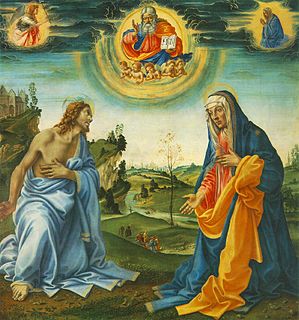 W
WThe Apparition of Christ to the Virgin is a painting by the Italian Renaissance master Filippino Lippi, executed around 1493 and now housed in the Alte Pinakothek of Munich, Germany.
 W
WThe Battle of Alexander at Issus is a 1529 oil painting by the German artist Albrecht Altdorfer, a pioneer of landscape art and a founding member of the Danube school. The painting portrays the 333 BC Battle of Issus, in which Alexander the Great secured a decisive victory over Darius III of Persia and gained crucial leverage in his campaign against the Persian Empire. The painting is widely regarded as Altdorfer's masterpiece, and is one of the most famous examples of the type of Renaissance landscape painting known as the world landscape, which here reaches an unprecedented grandeur.
 W
WThe Battle of the Amazons or Amazonomachia is an oil on wood painting produced around 1615. It shows an amazonomachy. It is usually attributed to Rubens, showing his huge admiration for Leonardo da Vinci and his The Battle of Anghiari, though the biographer Giovanni Pietro Bellori has attributed it to Anthony van Dyck. It is now in the Alte Pinakothek in Munich.
 W
WThe Blonde Odalisque or Resting Girl is the title of two paintings by François Boucher. The first dates to 1751 and is now in the Wallraf–Richartz Museum in Cologne, whilst the second was produced in 1752 and is now in the Alte Pinakothek in Munich. The model may be Marie-Louise O'Murphy, mistress of Louis XV for two years. They belong to the odalisque genre.
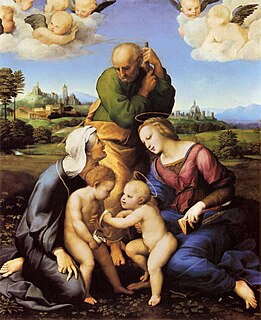 W
WThe Canigiani Holy Family or Canigiani Madonna is a painting by the Italian High Renaissance artist Raphael from 1508. It is part of the permanent collection of the Alte Pinakothek in Munich, Germany.
 W
WChrist and the Penitent Sinners or Christ with the four great penitents is a 1617 oil painting by Peter Paul Rubens. It is now in the Alte Pinakothek in Munich. It shows Jesus Christ with Mary Magdalene, Saint Peter, Dismas and King David.
 W
WThe Crowning with Thorns or Christ Crowned with Thorns is an oil-on-canvas 1576 painting by Titian, now in the Alte Pinakothek in Munich. It is a typical composition from his final period. and can be compared with an earlier 1542 work of his on the same subject.
 W
WThe Defeat of Sennacherib is a painting by Peter Paul Rubens, now in the Alte Pinakothek in Munich, produced between around 1612 and 1614. It shows the defeat of the army of Sennacherib by an angel, as described in the Old Testament. It is a pendant to The Conversion of Saint Paul, now in the Courtauld Gallery in London.
 W
WThe Deposition is a 1615 painting by the Flemish artist Anthony van Dyck. It is now in the Alte Pinakothek in Munich. He later reworked it in his 1619 version of the subject.
 W
WThe Deposition is a 1634 painting by the Flemish artist Anthony van Dyck. It is now in the Alte Pinakothek in Munich. The artist had already treated the same subject on at least two other occasions, in 1615 and 1619.
 W
WThe Descent from the Cross is a 1633 painting of the Descent from the Cross by Rembrandt. It is now in the Alte Pinakothek in Munich. It is a companion piece to Rembrandt's later The Raising of the Cross.
 W
WThe Disrobing of Christ or El Expolio is a painting by El Greco begun in the summer of 1577 and completed in the spring of 1579 for the High Altar of the sacristy of the Cathedral of Toledo, where it still normally hangs. In late 2013 it was on temporary display at the Prado in Madrid, following a period of cleaning and conservation work there; it was returned to Toledo in 2014. It is one of El Greco's most famous works. A document dated July 2, 1577 which refers to this painting is the earliest record of El Greco's presence in Spain. The commission for the painting was secured thanks to El Greco's friendship from Rome with Luis, the son of Diego de Castilla, the dean of the Cathedral of Toledo. De Castilla senior also arranged El Greco's other major commission, on which he worked simultaneously, the paintings for the Toledan church of Santo Domingo el Antiguo.
 W
WThe Fall of the Damned, alternately known as The Fall of the Rebel Angels is a monumental religious painting by Peter Paul Rubens. It features a jumble of the bodies of the damned, hurled into abyss by archangel Michael and accompanying angels.
 W
WThe Flight into Egypt is an oil-on-copper cabinet painting by the German artist Adam Elsheimer dating from about 1609, while he was in Rome. It is thought to be the first naturalistic rendering of the night sky in Renaissance art. At Elsheimer's death in Rome in 1610, this picture was hanging in his bedroom. Like many other artists before and after him, Elsheimer has depicted the biblical Flight into Egypt, in which Joseph, Mary, and Jesus seek refuge from possible persecution by Herod. For its innovative fusing of religious and landscape elements, and its detailed juxtaposition of light and darkness, The Flight into Egypt is one of Elsheimer's most well-known and lauded works. It is also likely his last painting, for he died a year later.
 W
WThe Great Last Judgement is an oil on canvas altarpiece, painted by the Flemish artist Peter Paul Rubens between 1614 and 1617. He created the composition and final touches and his is the only signature on the work, though it is believed between nine and nineteen studio assistants also worked on it. Its name distinguishes it from the same artist's The Small Last Judgement of 1619 and his The Fall of the Damned of 1620.
 W
WHelena Fourment with her son Frans is a c.1635 painting by Peter Paul Rubens, showing his second wife Helena Fourment holding their second son Frans. As of 2014, it is in the Alte Pinakothek in Munich.
 W
WThe Hippopotamus and Crocodile Hunt is an oil painting on canvas by Peter Paul Rubens. It was commissioned in 1615 to decorate Schleißheim Palace, along with three other works depicting lion, wolf, and boar hunts. The cycle of paintings were looted from the palace during the Napoleonic Wars. Only the Hippopotamus and Crocodile Hunt was returned to Munich, at which time it was added to the collection that is now the Alte Pinakothek.
 W
WThe Honeysuckle Bower is a self-portrait of the Flemish Baroque painter Peter Paul Rubens and his first wife Isabella Brant. They wed on 3 October 1609, in St. Michael's Abbey, Antwerp, shortly after he had returned to the city after eight years in Italy.
 W
WJudith is a c.1620-1625 painting by Simon Vouet of Judith, now in the Alte Pinakothek in Munich.
 W
WLamentation of Christ is an oil-on-panel painting of the common subject of the Lamentation of Christ by the German Renaissance artist Albrecht Dürer, executed around 1500 and now in the Alte Pinakothek of Munich, Germany.
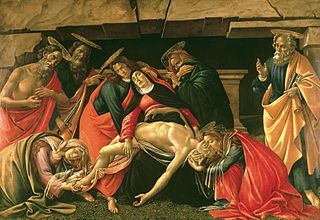 W
WThe Lamentation over the Dead Christ, is a painting of the common subject of the Lamentation of Christ by the Italian Renaissance master Sandro Botticelli, finished around 1490–1492. It is now in the Alte Pinakothek, in Munich.
 W
WHet Luilekkerland — known in English as The Land of Cockaigne — is a 1567 oil painting by Pieter Bruegel the Elder. In medieval times, Cockaigne was a mythical land of plenty, but Bruegel's depiction of Cockaigne and its residents is not meant to be a flattering one. He chooses rather a comic illustration of the spiritual emptiness believed to derive from gluttony and sloth, two of the seven deadly sins.
 W
WThe Last Judgment is a triptych created by a follower of Hieronymus Bosch. Unlike the other two triptychs with the same name, in Vienna and in Bruges, only a fragment of this one exists today. It resides at the Alte Pinakothek in Munich.
 W
WThe Life of Christ is a series of seven paintings in tempera and gold on panel, attributed to Giotto and dating to around 1320–1325. Depicting the Nativity and Passion of Christ, and Pentecost, they are now housed in a number of museums: three are in the Alte Pinakothek in Munich, and the Metropolitan Museum of Art in New York, the Isabella Stewart Gardner Museum in Boston, the Berenson Collection in Settignano and the National Gallery in London all have one each.
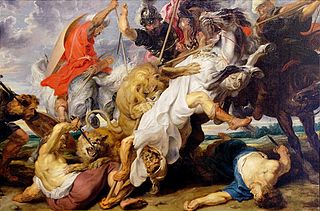 W
WThe Lion Hunt is a 1621 painting by Peter Paul Rubens, now held in the Alte Pinakothek in Munich. It shows two lions attacked by hunters on horseback and on foot. It marks the end of an intensive creative phase for Rubens centered on the theme of hunting.
 W
WMadonna and Child is a c.1492-1493 tempera on panel tondo painting by Luca Signorelli, now in the Alte Pinakothek in Munich. The rocky landscape in the background shows the influence of Leonardo da Vinci, whilst to the right is a nude seated on a rock, referencing the marble Spinario, which at that date was already in the Uffizi in Florence.
 W
WThe Madonna della tenda is a 1514 painting by the Italian renaissance artist Raphael. It shows Mary embracing the child Christ, while the young John the Baptist watches. The design of the painting resembles that of the Madonna della seggiola from the same period.
 W
WThe Madonna of the Carnation, also known as the Madonna with Vase, Madonna with Child or Virgin with Flower, is a Renaissance oil painting by Leonardo da Vinci created around 1478–1480. It is permanently displayed at the Alte Pinakothek gallery in Munich, Germany.
 W
WMars and Venus Surprised by Vulcan or Venus, Vulcan and Mars is a 1551-1552 oil on canvas painting by Jacopo Tintoretto, now in the Alte Pinakothek in Munich.
 W
WThe Massacre of the Innocents is the subject of two paintings by Peter Paul Rubens depicting the episode of the biblical Massacre of the Innocents of Bethlehem, as related in the Gospel of Matthew (2:13-18). The first, measuring 142 x 182 cm, was painted after his return to his native Antwerp in 1608, following eight years spent in Italy.
 W
WMerry Company is a 1622 oil on canvas painting by the Dutch artist Gerard van Honthorst. Set in a tavern, it is also known as The Prodigal Son, The Return or Celebratory Party. It is now in the Alte Pinakothek in Munich. The Merry Company, showing a group of drinkers, was a common subject-type in Dutch Golden Age painting.
 W
WThe Mocking of Christ is an early oil on wood painting (1503–1505) by Matthias Grünewald. It is located today in the Alte Pinakothek, Munich.
 W
WMystic Marriage of Saint Catherine is a 1506-1508 oil on panel painting by Italian Renaissance artist Lorenzo Lotto, signed on Catherine of Alexandria's broken wheel "Laurent.[ius] Lotus F.[ecit]". It is known to have moved from the Würzburg Residence to the Hofgartengalerie in 1804 and then to its present home in the Alte Pinakothek in Munich.
 W
WThe Myth of Prometheus is a series of two panels painted by Piero di Cosimo, executed in 1515. It shows Prometheus standing before a life-size statue.
 W
WThe Nativity of the Virgin is a painting by the German Renaissance artist Albrecht Altdorfer, dating to c. 1520, which is now in the Alte Pinakothek in Munich, Germany.
 W
WThe Paumgartner altarpiece is an early triptych painting by Albrecht Dürer, commissioned by the Paumgartner family of Nuremberg. The central panel depicts a nativity scene, while the wings depict Saint George (left) and Saint Eustace (right). The saint's faces are donor portraits of the brothers Stephan and Lukas Paumgartner, respectively. Other members of the Paumgartner family are depicted as small figures in the center panel.
 W
WPortrait of an Ecclesiastic is a c.1545 oil on canvas painting by Moretto da Brescia, now in the Alte Pinakothek in Munich, Germany. It was acquired in 1838 in Venice by marquess Canova.
 W
WThe Portrait of Charles V is an oil on canvas portrait of Charles V, Holy Roman Emperor by Titian, painted in 1548. As with the Equestrian Portrait of Charles V, it was commissioned by Charles during Titian's stay at the imperial court at Augsburg. It is now in the Alte Pinakothek in Munich, Germany.
 W
WThe Rainbow Landscape is a 1640 oil on panel painting by Peter Paul Rubens, now in the Alte Pinakothek in Munich One of the painter's last works and the third of three autograph works on the same subject, it mixes Italian and Flemish style in a fashion reminiscent of Rubens' friend Jan Bruegel the Elder but with figures drawing on nymphs in the work of Annibale Carracci and Domenichino.
 W
WThe Rape of the Daughters of Leucippus is a 1618 painting by Peter Paul Rubens and Jan Wildens. It is displayed at the Alte Pinakothek in Munich.
 W
WRest on the Flight into Egypt is a 1630 painting by Anthony van Dyck, probably commissioned by a layman. Featuring the Holy Family of Joseph, Mary, and Jesus, it was owned by Maximilian II Emanuel, Elector of Bavaria and is now in the Alte Pinakothek in Munich. The Rest on the Flight into Egypt was a popular subject in art.
 W
WThe Sacrifice of Isaac is a 1635 autograph oil on canvas work by Rembrandt, now in the Hermitage Museum. A studio copy of it dating to 1636 is now in the Alte Pinakothek in Munich.
 W
WThe Satyr and the Peasant is one of seven paintings by the Flemish painter Jacob Jordaens on the tale of the Satyr and the Peasant from Aesop's Fables. One version is now in the Royal Museum of Fine Arts of Belgium in Brussels, another in the Alte Pinakothek in Munich.
 W
WSelf-Portrait is a panel painting by the German Renaissance artist Albrecht Dürer. Painted early in 1500, just before his 29th birthday, it is the last of his three painted self-portraits. Art historians consider it the most personal, iconic and complex of his self-portraits.
 W
WThe Seven Sorrows Polyptych is an oil on panel painting by Albrecht Dürer. The painting includes a central picture, currently at the Alte Pinakothek in Munich, and seven surrounding panels which are exhibited at the Gemäldegalerie Alte Meister of Dresden.
 W
WThe Small Last Judgement is a 1619 painting by Peter Paul Rubens. Its name distinguishes it from the same artist's The Great Last Judgement of 1617. It is now in the Alte Pinakothek in Munich.
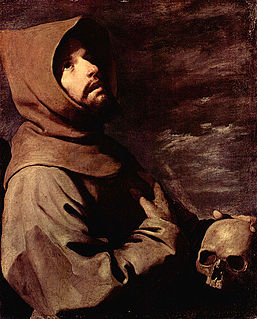 W
WSt. Francis in Ecstasy is a painting of 1658–1660 by Francisco de Zurbarán in the Alte Pinakothek in Munich, where it has been since 1836.
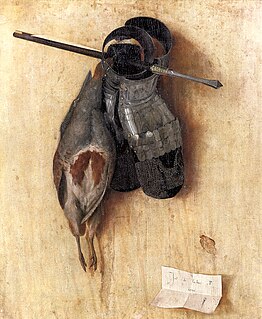 W
WStill-Life with Partridge and Gauntlets is a 1504 painting by the Italian painter Jacopo de' Barbari. It measures 52 cm × 42.5 cm and is held by the Alte Pinakothek in Munich. The small oil-on-limewood-panel painting is considered to be one of the earliest examples of a still life painting, and one of the first trompe-l'œil paintings, to be made in Europe since classical antiquity.
 W
WThe Suicide of Lucretia is an oil on lime panel painting by Albrecht Dürer, signed and dated 1518, in the collection of the Alte Pinakothek, Munich. It shows the Ancient Romean heroine Lucretia, wife of Lucius Tarquinius Collatinus, in a tall and narrow framing, in the act of killing herself rather than face the shame of being raped by her cousin Sextus Tarquinius. Lucretia stands in front of a cramped and harshly lit room containing the bridal bed on which she was raped. She looks to the sky, as if asking the gods to witness her suicide. Her face betraying feelings of disgrace, as she stabs herself with a sword to the belly. The panel is Dürer's second treatment of Lucretia, following a very similar 1508 drawing. The earlier composition, drawn in ink with wash on paper, is in the Albertina museum, Vienna.
 W
WSusanna and the Elders is a c.1621-1622 oil on canvas painting by Anthony van Dyck, now in the Alte Pinakothek in Munich, which acquired it in 1806 from the Düsseldorf Gallery.
 W
WThe Tempi Madonna is an oil painting by the Italian High Renaissance painter Raphael. Painted for the Tempi family, it was bought by Ludwig I of Bavaria in 1829. It is housed in the Alte Pinakothek in Munich. It is thought to have been made in 1508, at the end of the artist's Florentine period.
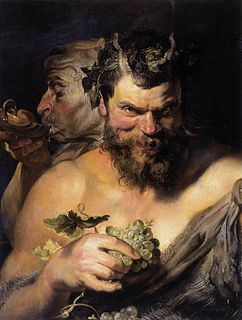 W
WTwo Satyrs is a 1618-1619 oil on canvas painting by Peter Paul Rubens. It measures 76 by 66 cm and is now in the Alte Pinakothek in Munich.
 W
WVanity is an oil painting by the Italian late Renaissance painter Titian, dated to around 1515 and now held at the Alte Pinakothek in Munich, Germany.
 W
WThe Munich Virgin Annunciate is a painting by the Italian Renaissance artist Antonello da Messina. Like the more famous Palermo version of the same subject, it shows Mary interrupted at her reading by the Angel of the Annunciation.
 W
WThe Virgin appearing to St. Bernard is a painting by the Italian artist Pietro Perugino, the main painter of the Umbrian school that was based in Perugia. The panel was executed as an altarpiece for the church of Santa Maria Maddalena dei Pazzi in Florence. It was later acquired in 1829/30 for King Ludwig I of Bavaria from the Capponi in Florence, and eventually made it to the Alte Pinakothek in Munich. The work has been called "one of the high points of European painting in the late 15th century."
 W
WThe Virgin Presenting Saint Rosalia to the Trinity is an oil on canvas painting, now in the Alte Pinakothek in Munich. Its poor condition makes attribution difficult, but it is usually attributed to Anthony van Dyck in his Sicilian period (1624-1625)
 W
WWillem van Heythuysen posing with a sword is a painting by the Dutch Golden Age painter Frans Hals, painted in 1625 and now in the Alte Pinakothek, Munich. It shows the Haarlem cloth merchant Willem van Heythuysen in a theatrical pose with a rapier.